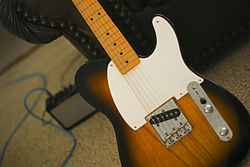Fender Esquire

Esquire in two-tone sunburst
|
|
| Manufacturer | Fender |
|---|---|
| Period | 1950 (original run) 1951–1969 (second run), with reproductions available later |
| Body type | Solid |
| Neck joint | Bolt-on |
| Scale | 25.5" |
| Body | Swamp Ash |
| Neck | Maple |
| Fretboard | Maple Rosewood |
| Bridge | Proprietary three-saddle string-through |
| Pickup(s) | 1 single-coil (some 1950 examples were equipped with 2 pickups) |
| Shades of blonde and white Various sunbursts |
|
The Fender Esquire is a solid-body electric guitar manufactured by Fender, the first "Spanish" style guitar sold by Fender, debuting in 1950. Shortly after its introduction, a two-pickup version was introduced and was renamed the Broadcaster a few months later; the single pickup version retained the Esquire name. The Gretsch Company at the time marketed a drum set under the 'Broadkaster' name, and at their request, Fender dropped the Broadcaster name, eventually renaming their guitar the "Telecaster". The more versatile Broadcaster/Telecaster has since become one of Fender's most popular models with dozens of variations produced. Once the Telecaster was introduced, the Esquire became marketed as a lower-cost version. Over the following two decades, the availability of other low-cost models saw the Esquire's sales decline and the model was discontinued in 1969.
The model has since been reissued but remains a relatively "niche" guitar. Although the Esquire was the original model introduced, given the popularity and uninterrupted production of the Telecaster, the limited reissued Esquire models are generally regarded and billed as variants of the Telecaster.
The first prototype for the Esquire (and the later Telecaster) was completed by Leo Fender in the fall of 1949. The prototype shared with these guitars the now-familiar slab body shape with single cutaway to allow easier access to the upper frets. It likewise featured the distinctive combination bridge and pickup assembly, with a slanted pickup with individual pole pieces for each string, and three bridge saddles which allowed adjustment of string length in pairs and individual string height. The neck, like the first Esquires manufactured in 1950, was made from a single piece of maple without a truss rod. The neck was attached to the body with four screws and an anchor plate, unlike in traditional guitar construction, where a tenon on the neck is glued into the body. Unlike the Esquire, the neck was wider at the nut, and the had 3 tuners on each side. The prototype differed from the later production guitars in several other respects: the body was made of pinewood, it was painted opaque white, its pickguard did not extend above the strings, it lacked a selector switch, and its volume and tone knobs were mounted on a slanted plate. Like the production models, it had a removable pickup cover, but unlike the production models, the cover had straight sides. The prototype had only one pickup, as did Esquires manufactured from 1951 onwards.
...
Wikipedia
